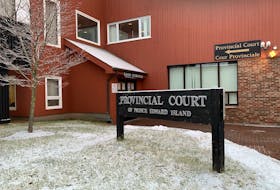Is getting power from the Muskrat Falls hydroelectric project on the Churchill River — chiefly for transmission and use outside of Labrador — worth risking methylmercury poisoning (or really life-changing restrictions on consuming country foods) for people downstream from the project?
The people at the Make Muskrat Right rally at the Colonial Building in St. John’s had their answer at the ready: No.
Any financial costs be damned.
The gathering included, at a rough count, 125 to 150 people who were not all familiar faces from past events. Some were holding signs calling for a halt to the Muskrat Falls project for the first time (at least until the methylmercury issue can be addressed), making it clear they are unsatisfied with the response to related questions and concerns to date.
Paul Peddle and Georgie Brown drove out from Torbay to be at the event Sunday afternoon. “It’s just wrong,” he said, convinced a worst-case scenario is about to play out, with methylmercury spiking to an unnecessary level when the reservoir area is flooded, resulting in dramatic changes for many people. “Something can be done about it and it’s just wrong to go ahead knowing you can stop it, knowing you can prevent it.”
Brown said more can and should be done, although Nalcor Energy has said what can and should be done at this point remains to be seen.
With his sunglasses on, protest signs could be seen reflected in the eyes of Chris Baird, regardless of the rain clouds overhead. More than one sign showed the head of “Silent Dwight” (aka premier Dwight Ball). Others demanded Crown corporation Nalcor Energy “Make Muskrat Right.”
“We got to this point because the (provincial) government, Nalcor, proceeded without social licence to proceed. Things aren’t always done in the best way and I think that’s how we got to where we are,” he said.
The project did go through a detailed environmental assessment process and was released by regulators with both levels of government, but the decision came with recommendations for more to be done on the subject of methylmercury. Nalcor Energy began surveys and consultant comparisons, but it was new, peer-reviewed research only fully available as of April, and promoted by the Nunatsiavut Government due to the significance, that provided the foundation for the current protest actions.
The study was supported by the Nunatsiavut Government, ArcticNet, the Oak Arctic Maritime Fund, the National Science Foundation, Memorial University of Newfoundland, the University of Manitoba and the Government of Canada.
It shows as many as 200 Inuit people of Nunatsiavut could exceed Health Canada guidelines under a worst-case scenario for methylmercury, without a drastic change in lifestyle and culture. Clear all of the trees and topsoil before making the reservoir, according to the report, and the number of people potentially at risk drops to about 30.
But it was also limited and still did not include the Innu Nation, members of the NunatuKavut Community Council and non-aboriginal people living in the area consuming large amounts of wild fish, birds and small game.
For its part, Nalcor Energy has not accepted the findings relating to human health risks.
There have been promises of joint monitoring, early warnings and compensation as required from the Crown corporation.
The provincial government more recently directed the removal of more trees (but not topsoil) from the reservoir area.
But the clear message from Labrador protestors, echoed at the St. John’s “Make Muskrat Right” rally, was that these measures are not going to be enough.
Denise Cole has been a constant figure at actions in support of the campaign. She took to the mic on the steps of the Colonial Building early in the event, reading a piece she had written after a visit to Muskrat Falls: “Muskrat Falls, She Speaks.”
“These ancient spirits, the ancestors of many Labradorians, including my own,” she said, reading, surrounded by Labrador flags and attempting to convey significance of place, supporting hunger strikers from the area who were taking the message to Ottawa.
There is a hold right now on reservoir flooding.
In a statement issued Saturday, the premier placed emphasis on a meeting coming Tuesday, involving leaders from the Innu Nation, the Nunatsiavut Government and the NunatuKavut Community Council. It remains to be seen if the leaders’ meeting will satisfy the public and “Make Muskrat Right.”
Is getting power from the Muskrat Falls hydroelectric project on the Churchill River — chiefly for transmission and use outside of Labrador — worth risking methylmercury poisoning (or really life-changing restrictions on consuming country foods) for people downstream from the project?
The people at the Make Muskrat Right rally at the Colonial Building in St. John’s had their answer at the ready: No.
Any financial costs be damned.
The gathering included, at a rough count, 125 to 150 people who were not all familiar faces from past events. Some were holding signs calling for a halt to the Muskrat Falls project for the first time (at least until the methylmercury issue can be addressed), making it clear they are unsatisfied with the response to related questions and concerns to date.
Paul Peddle and Georgie Brown drove out from Torbay to be at the event Sunday afternoon. “It’s just wrong,” he said, convinced a worst-case scenario is about to play out, with methylmercury spiking to an unnecessary level when the reservoir area is flooded, resulting in dramatic changes for many people. “Something can be done about it and it’s just wrong to go ahead knowing you can stop it, knowing you can prevent it.”
Brown said more can and should be done, although Nalcor Energy has said what can and should be done at this point remains to be seen.
With his sunglasses on, protest signs could be seen reflected in the eyes of Chris Baird, regardless of the rain clouds overhead. More than one sign showed the head of “Silent Dwight” (aka premier Dwight Ball). Others demanded Crown corporation Nalcor Energy “Make Muskrat Right.”
“We got to this point because the (provincial) government, Nalcor, proceeded without social licence to proceed. Things aren’t always done in the best way and I think that’s how we got to where we are,” he said.
The project did go through a detailed environmental assessment process and was released by regulators with both levels of government, but the decision came with recommendations for more to be done on the subject of methylmercury. Nalcor Energy began surveys and consultant comparisons, but it was new, peer-reviewed research only fully available as of April, and promoted by the Nunatsiavut Government due to the significance, that provided the foundation for the current protest actions.
The study was supported by the Nunatsiavut Government, ArcticNet, the Oak Arctic Maritime Fund, the National Science Foundation, Memorial University of Newfoundland, the University of Manitoba and the Government of Canada.
It shows as many as 200 Inuit people of Nunatsiavut could exceed Health Canada guidelines under a worst-case scenario for methylmercury, without a drastic change in lifestyle and culture. Clear all of the trees and topsoil before making the reservoir, according to the report, and the number of people potentially at risk drops to about 30.
But it was also limited and still did not include the Innu Nation, members of the NunatuKavut Community Council and non-aboriginal people living in the area consuming large amounts of wild fish, birds and small game.
For its part, Nalcor Energy has not accepted the findings relating to human health risks.
There have been promises of joint monitoring, early warnings and compensation as required from the Crown corporation.
The provincial government more recently directed the removal of more trees (but not topsoil) from the reservoir area.
But the clear message from Labrador protestors, echoed at the St. John’s “Make Muskrat Right” rally, was that these measures are not going to be enough.
Denise Cole has been a constant figure at actions in support of the campaign. She took to the mic on the steps of the Colonial Building early in the event, reading a piece she had written after a visit to Muskrat Falls: “Muskrat Falls, She Speaks.”
“These ancient spirits, the ancestors of many Labradorians, including my own,” she said, reading, surrounded by Labrador flags and attempting to convey significance of place, supporting hunger strikers from the area who were taking the message to Ottawa.
There is a hold right now on reservoir flooding.
In a statement issued Saturday, the premier placed emphasis on a meeting coming Tuesday, involving leaders from the Innu Nation, the Nunatsiavut Government and the NunatuKavut Community Council. It remains to be seen if the leaders’ meeting will satisfy the public and “Make Muskrat Right.”








